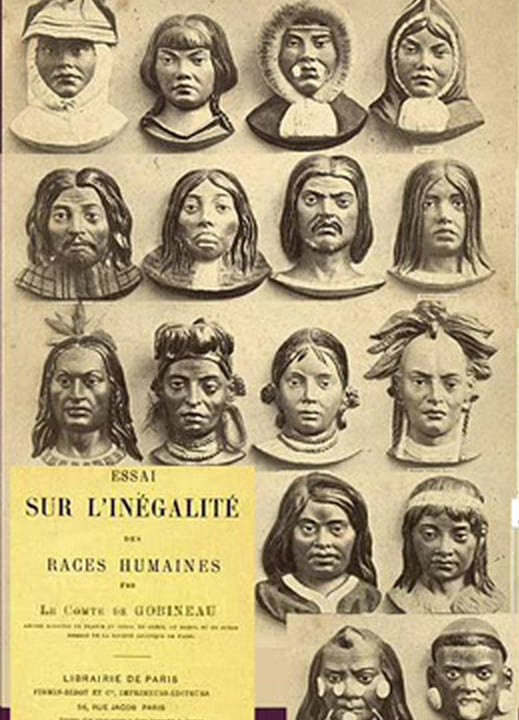Day 14 --
Tzvetan Todorov, On Human Diversity: Nationalism, Racism, and Exoticism in French Thought (Cambridge. Massachusetts: Harvard University Press, 1993, pp.108-110.
[p. 108]The classification of the major races
proposed by Le Bon . . . distinguishes four (not just three) degrees.
At the very bottom of the scale, we find the “primitive” races of the
“the aboriginal Australians are a case in point”; “no trace of culture” is
found in the primitive races, which “have remained in [a] state bordering on
animality” (The Psychology of Peoples, p. 27O.
Their fate is the one Renan had already evoked: “Experience proves
that every inferior people which is confronted with a superior people is
inevitably condemned to disappear at an early date” (p.51).
We are apparently dealing with a natural process that may be
justifiably accelerated to some extent: Le Bon doe not spell out the means
by which the “disappearance”
come about.
degrees.
At the very bottom of the scale, we find the “primitive” races of the
“the aboriginal Australians are a case in point”; “no trace of culture” is
found in the primitive races, which “have remained in [a] state bordering on
animality” (The Psychology of Peoples, p. 27O.
Their fate is the one Renan had already evoked: “Experience proves
that every inferior people which is confronted with a superior people is
inevitably condemned to disappear at an early date” (p.51).
We are apparently dealing with a natural process that may be
justifiably accelerated to some extent: Le Bon doe not spell out the means
by which the “disappearance”
come about.
On the next rung of the ladder, we find “the
inferior races,” of which blacks are the chief example.
As Renan these races are not perfectible.
They are “capable of attaining to the rudiments of civilization, but
to the rudiments only” (p.27); their members are “barbarians, condemned by
their mental inferiority never to shake off their barbarism” (p.104) . . .
The next race up, for Renan, is the "intermediate"
race – that is yellow: Chinese and
Japanese, Tartars and Mongols. Once again, its characteristics are derived
from its name: it is capable of being civilized but only up to a certain
point; it is inherently incomplete, having gone from a period of, infancy
straight into old age without ever achieving true maturity. China, that
shriveled old child" (Histoire du
peuple d'lsraël [History
of the People of lsrael], p. 33). In its turn China rejoins the nonhuman
part of humanity: “China is a sort of non-perfectible Europe. ( “Histoire de
l’instruction publique en Chine," p. 577). . . . The value judgment leaves
no room for doubt: "China . . . has always been inferior to our West even in
its worst days" ("The Future of Religion in Modern Society," p. 342). A
given language and culture [p.109] are clearly being measured here by the
yardstick of another language and culture; hence, every difference is
perceived as a lack. But what justifies the choice of one particular
language and culture as a norm?
Renan does not linger over this; he is dealing with self-evident facts, and
he does not seek out supporting arguments. . . .
At the top, for Renan, we have the "superior," or
white, race, which has beauty on its side, subject, as was already the case
for Buffon, to absolute judgments. These two races, Aryan and Semitic, "have
in common, and are alone in possessing, the sovereign characteristic of
beauty”
(Histoire genirale, p. 576). These
races have never known the savage state and they have civilization in their
blood. . . . Civilization is innate
in some races, inaccessible to others: one could hardly ask for a clearer
way of disavowing the unity of the species and submitting to the verdict of
Providence. The proof, for Renan, is historical : only the various
representatives of the white race have contributed to the development of
world civilization. . . . The
inferior races are thus relegated to a kind of subhumanity.
With Le Bon we find only one human group left at the
top: “Only the Indo-European people can be classed among the superior races”
(p.27) As was the case for
Buffon, the criterion that makes this [p.110] classification possible for Le
Bon is reason and its consequences, technological inventions. "Among the
primitive and inferior races . . . . a greater or lesser incapacity to
reason is always met with" (p. 29); among the superior races, on the
contrary, we find "great inventions arts, the sciences, and industry . . . ,
it is they who have discovered steam and electricity" (p. 28). The
difference between the top scale and the bottom is immense. Renan had
already declared that ,”as for the inferior races . . . , an abyss separates
them from the great families of whom we have just been speaking" (Histoire
générale, pp. 580-581), and Le Bon repeats: "The mental abyss that
separates them is evident" (The
Psychology of Peoples, p. 28).